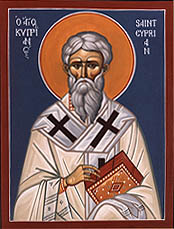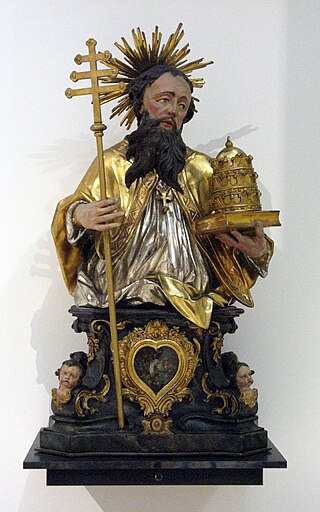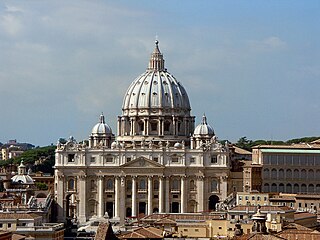Related Research Articles

Canonization is the declaration of a deceased person as an officially recognized saint, specifically, the official act of a Christian communion declaring a person worthy of public veneration and entering their name in the canon catalogue of saints, or authorized list of that communion's recognized saints.

The pope is the bishop of Rome and the visible head of the worldwide Catholic Church. He is also known as the supreme pontiff, Roman pontiff or sovereign pontiff. From the eighth century until 1870, the pope was the sovereign or head of state of the Papal States, and since 1929, of the much smaller Vatican City State. The current pope is Francis, who was elected on 13 March 2013.

Pope Linus was the bishop of Rome from c. AD 68 to his death. He is generally regarded as the second Bishop of Rome, after St. Peter. As with all the early popes, he was canonized.
Pope Agapetus I was the bishop of Rome from 13 May 535 to his death. His father, Gordianus, was a priest in Rome and he may have been related to two popes, Felix III and Gregory I.
Pope Boniface IV, OSB was the bishop of Rome from 608 to his death. Boniface had served as a deacon under Pope Gregory I, and like his mentor, he ran the Lateran Palace as a monastery. As pope, he encouraged monasticism. With imperial permission, he converted the Pantheon into a church. In 610, he conferred with Bishop Mellitus of London regarding the needs of the English Church. He is venerated as a saint in the Catholic Church with a universal feast day on 8 May.

The Second Ecumenical Council of the Vatican, commonly known as the Second Vatican Council or Vatican II, was the 21st and most recent ecumenical council of the Catholic Church. The council met in Saint Peter's Basilica in Vatican City for four periods, each lasting between 8 and 12 weeks, in the autumn of each of the four years 1962 to 1965.

Pope Anacletus, also known as Cletus, was the bishop of Rome, following Peter, and Linus. Anacletus served between c. AD 80 and his death, c. AD 92. Cletus was a Roman who, during his tenure as pope, ordained a number of priests and is traditionally credited with setting up about twenty-five parishes in Rome. Although the precise dates of his pontificate are uncertain, he "...died a martyr, perhaps about 91". Cletus is mentioned in the Roman Canon of the mass; his feast day is April 26.

The Holy See exercised sovereign and secular power, as distinguished from its spiritual and pastoral activity, while the pope ruled the Papal States in central Italy.

The Mass of Paul VI, also known as the Ordinary Form or Novus Ordo, is the most commonly used liturgy in the Catholic Church. It was promulgated by Pope Paul VI in 1969 and its liturgical books were published in 1970; those books were then revised in 1975, they were revised again by Pope John Paul II in 2000, and a third revision was published in 2002.

Cesare Baronio, C.O. was an Italian Oratorian, cardinal and historian of the Catholic Church. His best-known works are his Annales Ecclesiastici, which appeared in 12 folio volumes (1588–1607). He is under consideration for sainthood and, in 1845, Pope Benedict XIV declared him "Venerable."
A martyrology is a catalogue or list of martyrs and other saints and beati arranged in the calendar order of their anniversaries or feasts. Local martyrologies record exclusively the custom of a particular Church. Local lists were enriched by names borrowed from neighbouring churches. Consolidation occurred, by the combination of several local martyrologies, with or without borrowings from literary sources.
Since the thirteenth century it has been customary for the pope to assign to a particular prelate, and since 1420 to one with the rank of cardinal, a special responsibility in the Roman Curia for the interests of a given religious order or institute, confraternity, church, college, city, nation, etc. Such a person is known as a "cardinal protector". He was its representative or spokesman (orator) when it sought a favor or a privilege, defended it when unjustly accused, and sought the aid of the Holy See when its rights, property or interests were violated or imperiled. The cardinal protector was a position with an extensive juridical responsibility that gave the cardinal ample powers.

Papal supremacy is the doctrine of the Catholic Church that the Pope, by reason of his office as Vicar of Christ, the visible source and foundation of the unity both of the bishops and of the whole company of the faithful, and as pastor of the entire Catholic Church, has full, supreme, and universal power over the whole church, a power which he can always exercise unhindered: that, in brief, "the Pope enjoys, by divine institution, supreme, full, immediate, and universal power in the care of souls."

The Roman Catholic Diocese of Ferentino existed until 1986, when it was united into the new diocese of Frosinone-Veroli-Ferentino.
Summorum Pontificum is an apostolic letter of Pope Benedict XVI, issued in July 2007. This letter specifies the circumstances in which priests of the Latin Church could celebrate Mass according to what Benedict XVI called the "Missal promulgated by Blessed John XXIII in 1962" and administer most of the sacraments in the form used before the liturgical reforms that followed the Second Vatican Council.

According to the Catholic Church, a Church Council is ecumenical ("world-wide") if it is "a solemn congregation of the Catholic bishops of the world at the invitation of the Pope to decide on matters of the Church with him". The wider term "ecumenical council" relates to Church councils recognised by both Eastern and Western Christianity.
The following outline is provided as an overview of and topical guide to the Catholic Church:
The Catholic Church utilizes the oldest continuously functioning legal system in the West, much later than Roman law but predating the evolution of modern European civil law traditions. The history of Latin canon law can be divided into four periods: the jus antiquum, the jus novum, the jus novissimum and the Code of Canon Law. In relation to the Code, history can be divided into the jus vetus and the jus novum. Eastern canon law developed separately.
Traditionis custodes is an apostolic letter issued motu proprio by Pope Francis, promulgated on 16 July 2021 regarding the continued use of pre-Vatican II rites. It restricts the celebration of the Tridentine Mass of the Roman Rite, sometimes colloquially called the "Latin Mass" or the "Traditional Latin Mass". The apostolic letter was accompanied by an ecclesiastical letter to the Catholic bishops of the world.

In the Catholic Church, preconciliar Latin liturgical rites coexist with postconciliar rites. In the years following the Second Vatican Council, Pope Paul VI initiated significant changes. Some of Paul VI's contemporaries, who considered the changes to be too drastic, obtained from him limited permission for the continued use of the previous Roman Missal. In the years since, the Holy See has granted varying degrees of permission to celebrate the Roman Rite and other Latin rites in the same manner as before the council. The use of preconciliar rites is associated with traditionalist Catholicism.
References
- ↑ Gerhard Schwartz, Die besetzung der bistümer Reichsitaliens unter den sächsischen und saliche kaisern : mit den listen der bischöfe, 951-1122, Leipzig-Berlin, 1913, p. 281.
- ↑ Patrologia Latina , vol. CXLVI (1853), coll. 1369-1370.
- ↑ Dictionnaire d'Histoire et de Géographie Ecclésiastiques, vol. III (1924), col. 1106.
- ↑ Giovanni Lucchesi, BSS, vol. XI (1968), col. 44.
- ↑ Roman Martyrology (2004), p. 975.